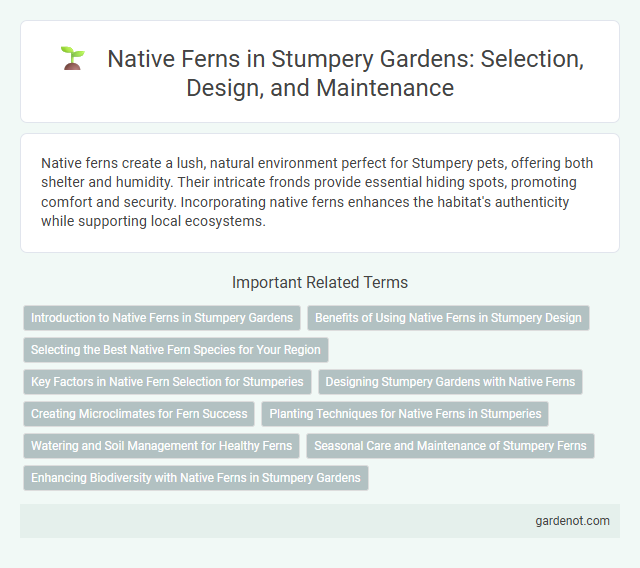Native ferns create a lush, natural environment perfect for Stumpery pets, offering both shelter and humidity. Their intricate fronds provide essential hiding spots, promoting comfort and security. Incorporating native ferns enhances the habitat's authenticity while supporting local ecosystems.
Introduction to Native Ferns in Stumpery Gardens
Native ferns in stumpery gardens thrive in shaded, moist environments where decaying wood creates a natural habitat rich in nutrients and moisture retention. Species such as the Lady Fern (Athyrium filix-femina) and the Male Fern (Dryopteris filix-mas) are commonly used, providing lush greenery and architectural interest. Their ability to colonize wood debris enhances biodiversity and supports woodland ecosystems within the stumpery landscape.
Benefits of Using Native Ferns in Stumpery Design
Native ferns enhance stumpery design by promoting biodiversity and providing essential habitats for local wildlife, including amphibians and insects. Their adaptive growth patterns require minimal maintenance, contributing to sustainable gardening practices. Using native ferns supports soil health through natural erosion control and moisture retention, improving overall garden resilience.
Selecting the Best Native Fern Species for Your Region
Selecting the best native fern species for your region requires understanding local climate, soil type, and moisture levels to ensure optimal growth and sustainability. Species such as Dryopteris marginalis thrive in shaded, well-drained areas, while Athyrium filix-femina prefers moist, acidic soils commonly found in temperate zones. Consulting regional native plant guides and collaborating with local botanical gardens enhances successful stumpery planting and preserves biodiversity.
Key Factors in Native Fern Selection for Stumperies
Native fern selection for stumperies hinges on shade tolerance, moisture requirements, and growth habit to ensure thriving under log-based structures. Species such as Athyrium filix-femina and Polystichum munitum exhibit robust adaptability to low light and damp soil conditions typical of stumpery environments. Prioritizing ferns with slow to moderate growth rates and resilient fronds maximizes aesthetic longevity and reduces maintenance in shaded garden displays.
Designing Stumpery Gardens with Native Ferns
Native ferns like Polystichum munitum and Adiantum pedatum thrive in shaded, moist environments, making them ideal for stumpery gardens. Incorporating these native ferns into a stumpery enhances biodiversity, provides natural ground cover, and adds lush, textured greenery that complements decaying wood. Strategic placement around tree stumps and logs promotes healthy growth while creating a visually appealing, sustainable garden ecosystem.
Creating Microclimates for Fern Success
Native ferns thrive in stumperies by benefiting from carefully created microclimates that provide consistent moisture, filtered light, and humidity levels mimicking their natural woodland habitats. Positioning decayed wood stumps and logs helps retain soil moisture and regulate temperature, promoting healthy fern growth. Optimizing these conditions ensures native fern species adapt well and maintain lush, vibrant foliage throughout the year.
Planting Techniques for Native Ferns in Stumperies
Planting native ferns in stumperies requires careful site selection with shaded, well-drained soil rich in organic matter to mimic their natural woodland habitat. Incorporate decaying wood and leaf mulch to maintain moisture and improve soil fertility, ensuring better root establishment and growth. Position ferns with adequate spacing to promote air circulation and prevent fungal diseases, enhancing their health and aesthetic appeal within the stumpery.
Watering and Soil Management for Healthy Ferns
Native ferns thrive in consistently moist, well-draining soil rich in organic matter such as leaf mold or compost, mimicking their natural forest floor habitat. Watering should be frequent enough to keep the soil evenly damp but never waterlogged, preventing root rot and encouraging healthy frond growth. Proper soil pH between 5.5 and 6.5 supports nutrient uptake, ensuring the fern's vigorous development in a stumpery setting.
Seasonal Care and Maintenance of Stumpery Ferns
Native ferns in stumperies require seasonal care that emphasizes moisture retention and shade management to mimic their natural woodland habitats. In spring and summer, maintaining consistent soil dampness and providing filtered light supports new frond growth, while autumn demands careful removal of dead foliage to prevent disease. Winter care focuses on mulching to protect roots from frost, ensuring the fern's resilience through colder months.
Enhancing Biodiversity with Native Ferns in Stumpery Gardens
Native ferns in stumpery gardens serve as vital components for enhancing biodiversity by providing essential habitats for various insects and small wildlife. Their adaptation to local soil and climate conditions supports native ecosystems, promoting the growth of indigenous flora and fauna. Incorporating a diverse range of native fern species into stumperies strengthens ecological resilience and fosters sustainable garden environments.
Native fern Infographic

 gardenot.com
gardenot.com